Child Maintenance Deduction from Earnings Order (DEO)
This guide explains what to do in Payroll Manager if the Child Maintenance Service (CMS) issues a formal notice to an employer instructing them to implement a Deduction from Earnings Order (DEO) in respect of an employee. Moneysoft Payroll Manager has all of the relevant rules and rates for the various types of DEO built in, and so once the relevant details have been entered into the software the amounts to be deducted from an employee in each pay period will be calculated automatically.
You should read the GOV.UK guidance Make child maintenance deductions from an employee’s pay: Overview – GOV.UK before proceeding.
How a DEO operates
The Child Maintenance Service (CMS) issue a formal notice to an employer instructing them to make deductions from an employee’s pay each pay period and to pay these amounts over to the CMS.
The DEO will specify:
- How much of the employee’s net pay is to be ‘protected’ against deductions (this is typically 60%)
- The amount to be deducted in each pay period.
Payroll Manager has all of the rules regarding DEOs built-in, and so is able to perform the calculations automatically.
How to enter the details of the Child Maintenance DEO in Payroll Manager
1) Select the appropriate employee on the ‘Pay Details‘ screen.
2) Click on the ‘Attachments‘ tab, then click on the (blue spanner) ‘Settings‘ button in the next available column.
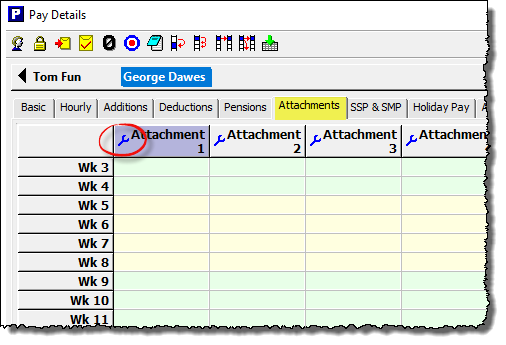
3) Select the ‘Child Maintenance DEO (protected percentage) ‘option from the drop-down list, unless the order that you have specifies otherwise.

4) Complete the other fields on this screen as per the instructions below:
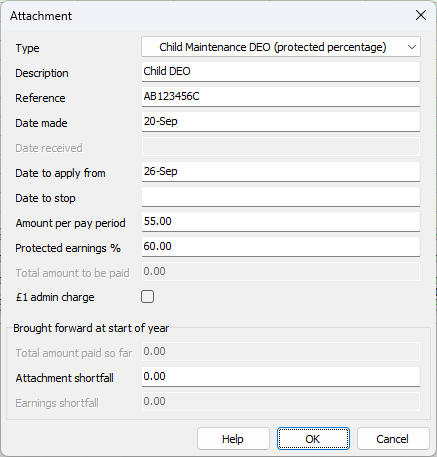
– Description: – Enter a description for this particular attachment – this can be whatever you like (e.g. Child DEO) and is only used as a column ‘label’ on the ‘Pay Details’ screen for that particular attachment, and also appears on the employee payslip.
– Reference: Use the reference given on the DEO order received. In the example the employee’s National Insurance Number (NINO) has been used as the reference.
– Date made: Enter the date that appears on the formal DEO notice.
– Date to apply from: Enter the date of the next available pay date for that employee. Make sure that the date that you enter is NOT in a pay period which has already been paid.
– Date to stop: Leave this field blank. ( If the Child Maintenance Service subsequently ask the employer to stop applying the DEO then the applicable stop date can be entered here – see section ‘Ending or editing a DEO- changes of circumstances’, below).
– Amount per pay period: Enter the amount that CMS have instructed to deduct per pay period.
– Protected earnings %: Enter the protected earnings percentage as specified on the DEO. In most cases this will be 60%.
– Total amount to be paid: This box will be greyed out in all circumstances as it does not apply to DEO attachments.
– £1 admin charge: The employer is allowed to deduct £1 for each pay period in which a DEO deduction is made if they wish, to cover their own admin costs. This is optional – tick/untick the box accordingly.
– Brought forward at start of year – Total amount paid so far: This box will be greyed out in all circumstances as it does not apply to DEO attachments.
– Attachment shortfall: this field is for situations where you are using Payroll Manager for the first time for a particular employer, and an employee has a DEO which has been in operation before the start of the tax year, or if you are starting to use Payroll Manager mid way through the tax year, having used other software previously. The box allows you to enter a ‘shortfall’ amount = i.e. an amount that was due in the previous pay period, but was not able to be collected because the earnings of the employee were not sufficient. Leave this field blank, otherwise.
Click ‘OK‘ when you have finished entering information on this screen.
How DEO deductions are calculated
Payroll Manager automatically calculates the amount to be deducted from the employee each pay period, according to the rules specified by the Child Maintenance Service, taking into account any ‘protected earnings’. If there is a ‘shortfall’ – i.e. the earnings of the employee are not high enough for the required amount of deduction to be made, then the software will automatically carry forward the shortfall to the next pay period. The calculated deduction amounts are then shown in the ‘Attachments‘ column of the ‘Pay Details‘ screen and are also itemised on the employee payslip.
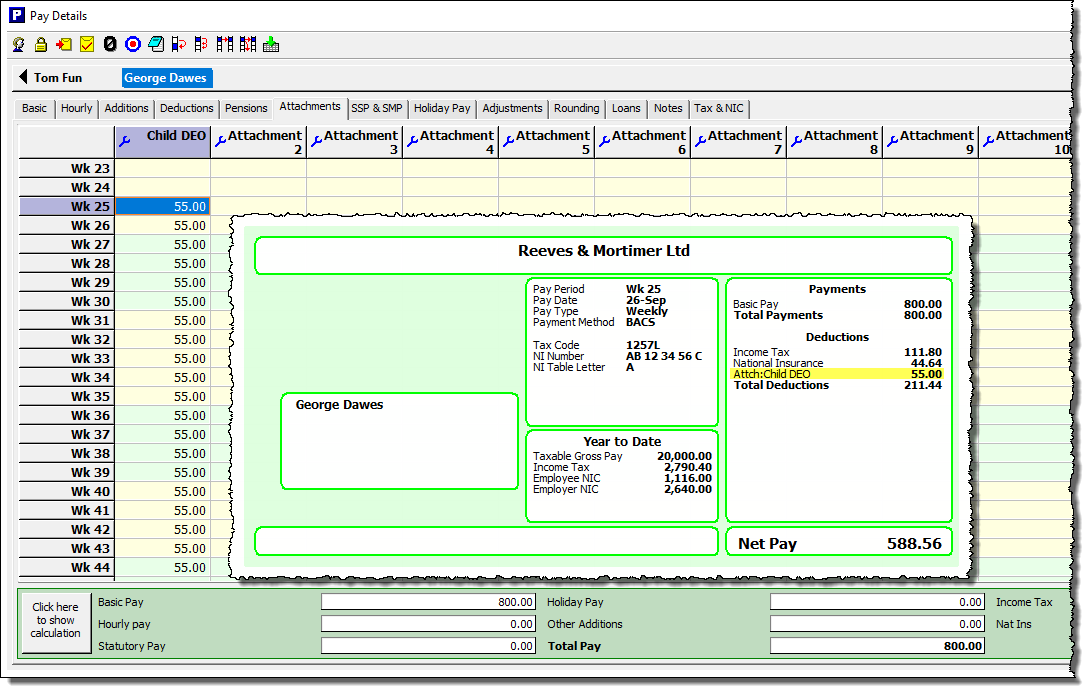
If you wish to see a full breakdown of how Payroll Manager has calculated the DEO deduction then click the button marked ‘Click here to show calculation‘ towards the bottom-left of the Pay Details screen, and select ‘Attachments‘.
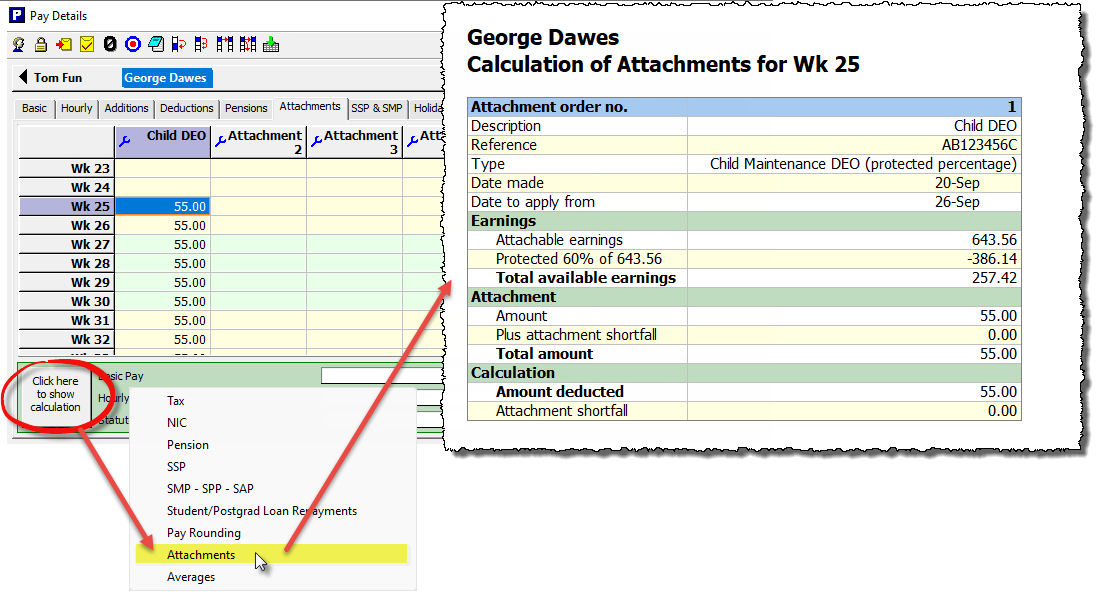
Note that the actual deduction is based on the ‘Attachable Earnings‘, which is not the same as the gross pay, but instead is the employee’s pay after the deduction of tax, national insurance, student/postgraduate loans, pension contributions and statutory parenting payments such as SMP. The DWP definition of what counts as ‘Earnings’ for this purpose can be found at Child Maintenance – What Counts As Earnings
Ending or editing a DEO- changes of circumstances
Payroll Manager will continue to calculate DEO deductions until a ‘Date to stop’ has been entered or if an employee leaves employment. If the employer is contacted by the Child Maintenance Service asking them to change the terms of the DEO (e.g. to start deducting a higher or lower amount) then it is very important NOT to edit an existing DEO within the software. Instead you should ‘end’ the existing DEO, and set up a brand new DEO column on the Pay Details screen to start collecting the new amount. This can be done as per the instructions below:
1) Click on the (blue spanner) ‘Settings‘ button in the column relating to the original DEO (i.e. the one that is ‘ending’).
2) Enter a ‘Date to stop‘ and click ‘OK‘. The ‘Date to stop’ should be the pay date of the last period for which you wish to original DEO amount to be deducted. Make sure that the ‘Date to stop’ is NOT in a pay period that has already been paid.
3) Click on the (blue spanner) ‘Settings‘ button in the next available attachments column.
4) Enter the details of the ‘new’ DEO, with the new ‘Amount per pay period’ making sure that the ‘Date to apply from’ is the pay date of the next pay period for that employee (i.e. the next pay date subsequent to the one entered in step 2, above). Click ‘OK‘ when you have finished.
The ‘Pay Details‘ screen will then show the details of the two DEO orders, as per the example below.
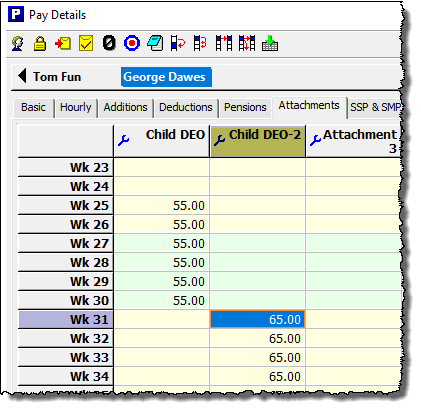
Reports in Payroll Manager
Payroll Manager has a number of reports available to help with the administration of DEO.
Click ‘Analysis‘ then ‘Attachments‘ from the main menu in Payroll Manager to view a report which gives the details of all attachments in operation for each employee.
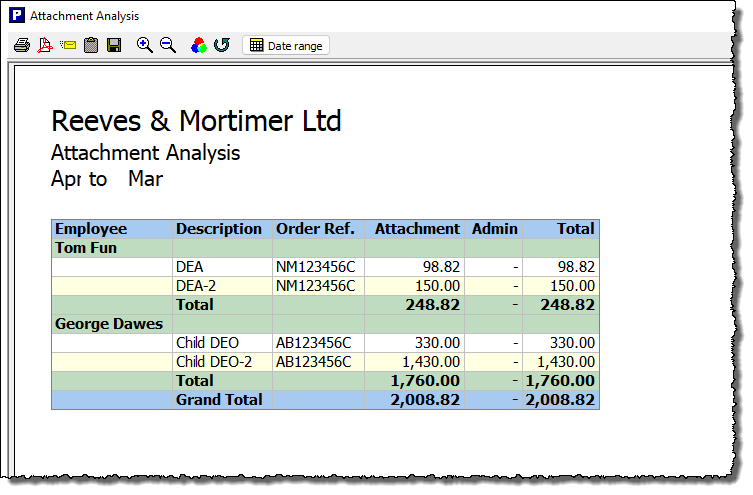
Click ‘Pay‘ then ‘Payments‘ and select ‘Attachments report’ to see a list of attachment payments due in any one particular pay period.

Making payments to the Child Maintenance Service
Payments should be sent to CMS as soon as possible, and must be received by CMS no later than the 19th of the month following the month that the deduction was made. The various payment method options are listed at Make child maintenance deductions from an employee’s pay: Make deduction from earnings order (DEO) payments – GOV.UK
FAQ
If an employee has a number of different attachments in operation at the same time, which one takes priority? – Different attachment orders take priority over each other according to their type (e.g. Child Maintenance, Council Tax, DEA etc) and the date that they were issued. Payroll Manager has all of the rules regarding priority built-in, and will automatically apply attachments in the correct priority order.
Links
Make child maintenance deductions from an employee’s pay: Overview – GOV.UK

